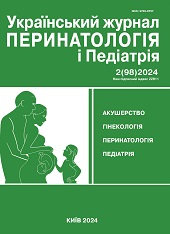Features of pregnancy and delivery management in a woman with Willebrand's disease: a case report
DOI:
https://doi.org/10.15574/PP.2024.98.122Keywords:
von Willebrand disease, infusion and transfusion therapy, postpartum haemorrhage, coagulopathyAbstract
Von Willebrand disease (VWD) is a serious medical problem. Women with VWD have a 1,5-fold increased risk of postpartum bleeding, the frequency of which ranges from 40% to 60%.
Аim - to analyse the features of prevention of obstetric bleeding in women with VWD on the basis of a clinical case.
The fluctuating nature of von Willebrand factor (VWF) and factor VIII during pregnancy prompts a thorough examination of pregnant women with VWD by a multidisciplinary team involving an obstetrician-gynaecologist, haematologist, anaesthetist and other specialists at a health care facility of the third level of perinatal care for the most appropriate treatment during delivery and in the postpartum period. When planning a delivery, it is advisable to prepare a sufficient amount of blood products and hemostatic drugs. Women with VWD have an increased risk of postpartum bleeding, and the volume and composition of infusion and transfusion therapy depends on the amount of blood loss. Prevention of both early and late postpartum bleeding requires medical therapy with uterotonic agents, factor VIII and VWF release inducers, antifibrinolytics, along with transfusion therapy, which helps to normalise coagulation hemostasis and restore the general condition of the postpartum woman. Infusion and transfusion therapy, haemostatic therapy with tranexamic acid, and a qualified technique for performing surgical delivery by caesarean section using argon-plasma coagulation for haemostasis allowed preserving the fertility of a woman with VWD with obstetric coagulopathic bleeding.
The study was performed in accordance with the main provisions of the Helsinki Declaration, and the patient's consent was obtained.
The authors declare no conflict of interest.
References
Castaman G, James PD. (2019). Pregnancy and delivery in women with von Willebrand disease. Eur J Haematol. 103: 73-79. https://doi.org/10.1111/ejh.13250; PMid:31107984 PMCid:PMC7604852
Committee on Adolescent Health Care, Committee on Gynecologic Practice. (2013). Committee Opinion No. 580: Von Willebrand disease in women. Obstet. Gynecol. 122: 1368-1373. https://doi.org/10.1097/01.AOG.0000438961.38979.19; PMid:24264714
Connell NT, Flood VH, Brignardello-Petersen R et al. (2021, Jan 12). ASH ISTH NHF WFH 2021 guidelines on the management of von Willebrand disease. Blood Adv. 5(1): 301-325. https://doi.org/10.1182/bloodadvances.2020003264; PMid:33570647 PMCid:PMC7805326
Kvartymed Ukraina. (2019). Doslidzhennia ahrehatsiinoi aktyvnosti trombotsytiv z vykorystanniam obladnannia STEELLEX. 2019.05. Metodychka-ahrehatsiia.
Lykissas MG, Gelalis ID, Kostas-Agnantis IP, Vozonelos G, Korompilias AV. (2012, May 9). The role of hypercoagulability in the development of osteonecrosis of the femoral head. Orthop Rev (Pavia). 4(2): e17. https://doi.org/10.4081/or.2012.e17
Marshall AL, Durani U, Bartley A et al. (2017). The impact of postpartum hemorrhage on hospital length of stay and inpatient mortality: a National Inpatient Sample-based analysis. Am J Obstet Gynecol. 217(3): 344.e1-344.e6. https://doi.org/10.1016/j.ajog.2017.05.004; PMid:28502758
McLintock K, James AG. (2011). Obstetric hemorrhage. J Thromb Haemost. 9: 1141-1151. https://doi.org/10.1111/j.1538-7836.2011.04398.x; PMid:21668737
MOZ Ukrainy. (2016). Khvoroba Villebranda. Klinichna nastanova, zasnovana na dokazakh. Derzhavnyi ekspertnyi tsentr MOZ Ukrainy. URL: https://www.dec.gov.ua/wp-content/uploads/2019/11/kn_vill.pdf.
Punt MC, Waning ML, Mauser-Bunschoten EP et al. (2020, Jan). Maternal and neonatal bleeding complications in relation to peripartum management in women with Von Willebrand disease: A systematic review. Blood Rev. 39: 100633. https://doi.org/10.1016/j.blre.2019.100633; PMid:31718817
Stoof SCM, van Steenbergen HW, Zwagemaker A et al. (2015). Primary postpartum haemorrhage in women with von Willebrand disease or carriership of haemophilia despite specialised care: a retrospective survey. Haemophilia. 21(4): 505-512. https://doi.org/10.1111/hae.12635; PMid:25688733
Downloads
Published
Issue
Section
License
Copyright (c) 2024 Ukrainian Journal of Perinatology and Pediatrics

This work is licensed under a Creative Commons Attribution-NonCommercial 4.0 International License.
The policy of the Journal “Ukrainian Journal of Perinatology and Pediatrics” is compatible with the vast majority of funders' of open access and self-archiving policies. The journal provides immediate open access route being convinced that everyone – not only scientists - can benefit from research results, and publishes articles exclusively under open access distribution, with a Creative Commons Attribution-Noncommercial 4.0 international license(СС BY-NC).
Authors transfer the copyright to the Journal “MODERN PEDIATRICS. UKRAINE” when the manuscript is accepted for publication. Authors declare that this manuscript has not been published nor is under simultaneous consideration for publication elsewhere. After publication, the articles become freely available on-line to the public.
Readers have the right to use, distribute, and reproduce articles in any medium, provided the articles and the journal are properly cited.
The use of published materials for commercial purposes is strongly prohibited.

